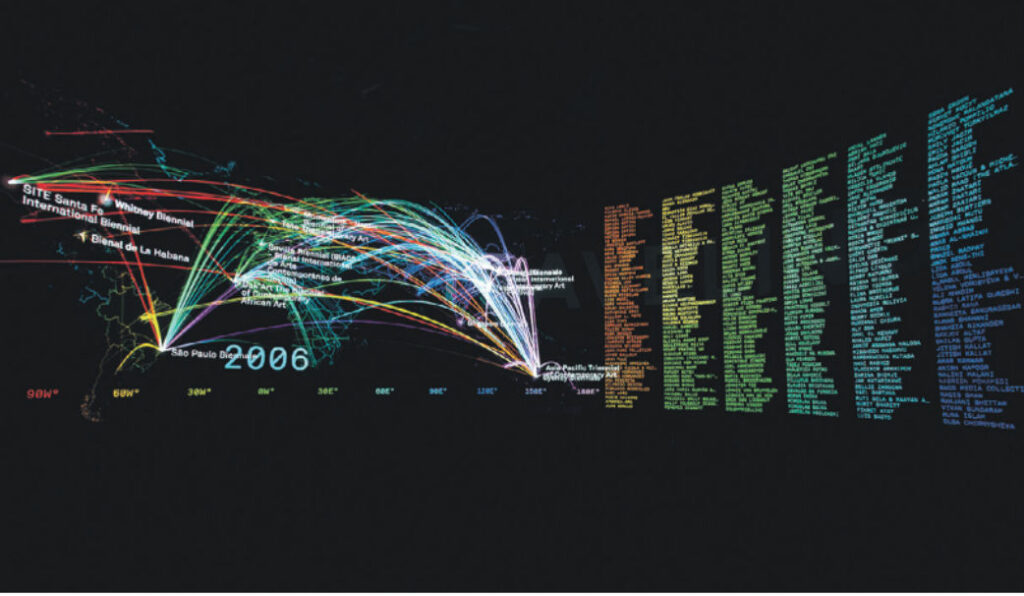What is biennialization? Simon Sheik’s interrogative article, published in the Humboldt journal in 2011, outlined reflections and issues that are still at the heart of the debate. In fact, yesterday as well as today, there is neither an easy nor a single answer to that question, as biennialization is a heterogeneous and mutant phenomenon.
At the end of the 1990s, in a recently unified Berlin, Gerhard Haupt coined this term to refer to the multiplication of biennials and the ubiquity of certain artists and curators, regardless of the characteristics of the place and the singularity of the mega-exhibition. In 1997, this time in Italy, exponents of the Venice-, São Paulo-, Istanbul-, Dakar-, Perth-, Pittsburg-, Costa Rica-, Havana-, Austin-, Sydney-, Bangkok- and Johannesburg biennials came together in a meeting organised by the Rockefeller Foundation. The purpose was to study and discuss “the rise and proliferation of large-scale international exhibitions“. On that occasion, the dissemination of the model was perceived to such extent as positive that Okwui Enwezor, who participated in the event, underlined that it offered the possibility of carrying out a “paradigm shift”.

Shortly afterwards, in 2001, the Revista de Occidente published a text by Ivo Mesquita that began with a seemingly infinite list of biennials. In a few lines the curator from São Paulo went through the five continents and finished by asking whether biennials are redundant or entropic. In those years a series of congresses that connected Europe, Asia and Australia was taking place within the event framework Biennials in Dialogue (2000-2008). The first was illustrated by the cartoon “What our village now needs is a biennial!”: a man, with a destroyed city behind him, delivers the resounding message to the camera. Olav Westphalen’s drawing captures the sogni e conflitti [dreams and conflicts] of the biennialization. In fact, the backdrop of the sentence uttered by the man is overwhelmingly complex: from the revolutionary dream of the Havana Biennial (1984) to the cascade effect of the Documenta (2002), via the Venetian replicas in São Paulo (1951) and Sydney (1973) and Maurizio Cattelan’s biennial-parody (1999).

What is biennialization? A democratic redistribution of cultural power or a new form of Western colonization? An inert repetition of a model or a challenge to provide new spaces and temporalities? The dichotomy is intrinsic to the concept as the very phenomenon it describes works in two ways. On the one hand, it contributes to the perpetuation of a dominant model, while at the same time questioning it; on the other, it challenges the system, while at the same time repeating and affirming it.
Bibliography
Enwezor, O. (2003/2004), «Mega-Exhibitions and the Antinomies of a Transnational Global Form», MJ. Manifesta Journal: journal of contemporary curatorship, 2, pp. 94-119.
Funcke, B. ed. (2001), 6th Carribean biennial, Dijon, Les presses du réel
Gardner, A., Green C. (2017), «Post-North? Documenta 11 and the Challenges of the “Global Exhibition” », OnCurating, 33, pp. 109-121.
Gardner, A., Green, C., eds., (2016), Biennials, Triennials and documenta : the exhibitions that created contemporary art, JohnWiley & Sons Inc., Hoboken.
Herández, M. Á. (2014), «Las bienales como obra de arte total», Revista de Occidente, 393, pp. 11-30.
Jiménez, C. (2004), «La Bienal de Berlín: un modelo de antibienalización? », ArtNeux, 55.
Marchart, O. (2008), Hegemonie im Kustfeld. Die documenta-Ausstellungen dX, D11, d 12 und die Politiki der Biennalisierung, n.b.k. Diskurs, Band 2 (Hg. Mairus Babias), Colonia, pp. 7-13.
Mesquita, I. (2001), “Bienales, bienales, bienales, bienales, bienales, bienales”, Revista de Occidente, 238, pp. 31-36.
Niemojewski, R. (2021), Biennials: The Exhibitions We Love to Hate, Lund Humphries, Londres.
Sassatelli, M. (2016), «The biennalization of the art worlds. The culture of cultural events» en Laurie Hanquinet, Mike Savage, eds., Routledge International Handbokk of the Sociology of Art and Culture, Toutledge, Londres / Nueva York, pp. 227.
Sheik, S. (2011), « Qué es la bienalización? Notas sobre la mediación cultural de las finanzas globales y la producción del capital cultural global», Humboldt, 156, pp. 41 – 44.
